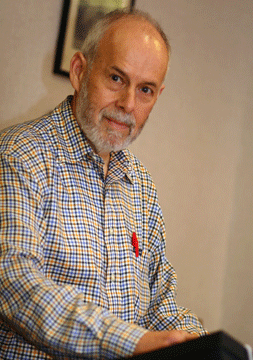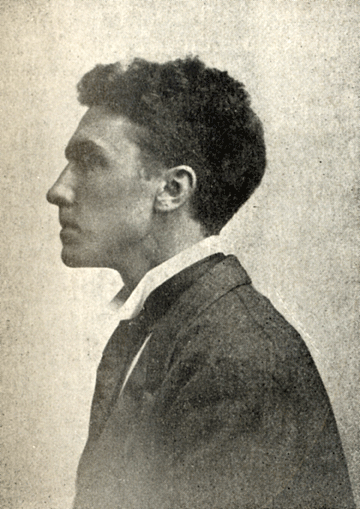 Dear Rader,
Dear Rader,
Events at Wabash much, yes MUCH funnier than any printed version
I have yet seen…
Yours, Ez P
Ezra Pound, in a letter to Jim Rader, March 1959
When, as a freshman at Wabash, I first became aware that the poet Ezra Pound had once taught there, it was almost 50 years after the fact. Now it has been 100 years; this school year marks the centennial of the classic encounter between rebel poet and staid Midwestern college that has become a staple item in American literary folklore.
I got hooked on the story.
What began as a discovery and a fascination became a major project during my undergraduate years and an abiding part-time pursuit during my adulthood. Over and over it has seemed that I couldn’t be done with it.
I probably would never have gotten hooked had I not discovered the story on my own. I was studying late one night in the dark recesses of Yandes Library searching through back issues of The Wabash to prepare for a speech about those early Little Giant basketball teams that became national powerhouses. I turned a page and there was the striking profile photo whose caption read: PROF. EZRA POUNDS/Romance Languages.
I could hardly contain my excitement as I rushed into the next room and brought back a biographical dictionary. Comparing colleges and dates from the entry on Pound, I quickly confirmed that, in spite of the misspelling of his
last name, it was indeed the celebrated poet who had come to teach at Wabash in the fall of 1907.
When I mentioned my discovery to one of my English professors, I learned that Pound’s brief tenure at Wabash was well known, especially the story about his having a woman in his room and being fired as a result. It had even been written up in the college’s centennial history.
Still, I couldn’t resist doing some cursory research to learn more about his stay in Crawfordsville.
In the spring of 1958, The Bachelor editor Roger Smith was planning a special magazine for Pan Hel weekend and, knowing of my interest in the Pound episode, asked me to write an article. For the next two weeks, I cut my classes and plunged into research in Wabash and Crawfordsville publications of 1907-08. I interviewed several Crawfordsville alumni, and wrote special-delivery letters to a couple of alumni from out of town and the one surviving faculty member besides Pound, and wrote my article.
To the body of knowledge about Pound’s five-month tenure, I managed to add a few new details: He arrived in mid-September 1907, just shy of his 22nd birthday, and departed on February 14, 1908. Soon after his arrival he bought a chafing dish, and while others went home for Thanksgiving, he stayed in Crawfordsville and dined on oysters from that chafing dish. He was seen by some students as a good, even excellent teacher, and by at least one as a fool and a misfit with nothing to offer his students. In January he began to cut chapel on a daily basis and his absences were duly noted in The Wabash. And when he left he was paid a lump sum of $200, almost half of his promised annual salary, by order of George L. Mackintosh, President of Wabash at the time.
Three days after it was published, I mailed a copy of my Bachelor article to Pound, with a rather sophomoric cover letter. Not surprisingly, he didn’t reply.
But I continued to research the topic in my spare time. I had a job in the Alumni Office and that probably helps explain how I got the idea of writing to all the alumni who had been at Wabash in 1907-08. English Professor Walter Fertig offered a $20 grant to pay for postage. My letter to the almost 200 alumni who survived from Pound’s time at Wabash went out on November 22, 1958. Eventually I would receive over 50 letters in response; about 35 of them included useful memories of Pound and his time at the college.
One former student said he been a part of the incident.
"I was a bit involved with the same escapade that brought his dismissal," wrote Dr. Roy G. Pearce, Class of 1908. "What he did was foolish but I do not believe that he did anything save give them, the ladies, a room to sleep in. I was questioned about the same affair but evidently was a more successful liar."
Lexemuel Hesler, Class of 1911, described the poet moments after he had been fired.
"One day," former Pound student Lexemuel Hesler wrote to me, "I started to Center Hall to register for the winter quarter. I met Ezra coming out the building, tears running down his face. One of the boys who had been in the class said: ‘Haven’t you heard? Old Doc Mac just fired Ezra.’"
 Another alumnus believed he was the last to see Pound before he left Crawfordsville.
Another alumnus believed he was the last to see Pound before he left Crawfordsville.
"I saw him at the Big Four Station, South Washington Street, and talked with him until he boarded the train leaving the city," wrote David Glasscock, Class of 1908. "In the course of our conversation I asked him why he was leaving. He replied that he was fired…I asked him why? He replied that the college board fired him because he had had a girl in his room. I asked if he had had one. He said, ‘Yes I did.’ And when he denied
it and asked the board to prove it they could not and because they could not they reinstated him. It was then that he told me he told the board ‘to go to Hell’ and resigned."
Having learned that a Crawfordsville High School student, Viola Baylis, had been one of Pound’s confidantes in 1907, I set about to track her down. This involved some detective work, but I eventually located her in California, and now Mrs. Wildman, and she and I corresponded for several years.
Among many other details, she described Pound as having "dressed in a cosmopolitan manner, wearing soft-collared shirts, wide flowing ties, velveteen jackets, patent-leather shoes, a wide-brimmed felt hat always atop his unruly hair."
Of the incident for which the poet was fired, Mrs. Wildman wrote to me: "He gave his room and bed to a ‘poor orphan in the storm.’ When he came, crushed, to discuss the episode with me, he explained how he had slept, fully clothed, on the floor."
Norman Holmes Pearson, a Pound scholar at Yale, heard of my Bachelor article and wrote asking
for a copy. He suggested that I write to Pound again, in Italy, and send him another copy of the piece.
This time the poet responded and offered some cryptic but valuable leads. His erratically-typed but fascinating note on letterhead from Rapallo, Italy, began:
Dear Rader,
Events at Wabash much, yes MUCH funnier than any printed version I have yet seen. Specially my having spent the evening when supposed to have been in flagrante with the widdy ole Mac was supposed to have wanted to espouse, and what she wrut to the President, I have never known in detail.
In the spring of 1959, Roger Smith became editor-in-chief of The Wabash Review. He asked me if I would do a further article on the subject. As a result I published two reminiscences, one from Mrs. Wildman, who was obviously enamored of the poet, and one from Fred H. Rhodes, class of 1910, a student in Pound’s beginning French class who had attended one of his teacher’s "soir™es" and was not impressed.
When the Review article was published, I sent a copy of the magazine to Pound and received a second letter from him, this one including an invitation to visit him in Italy. Unfortunately I never took him up on the invitation. In 1975, while doing research at Yale’s Beinecke Library, I met Pound’s daughter, Mary de Rachewilz. She volunteered that in 1959 her father was not extending very many invitations to anyone.
When I left Wabash at the end of my junior year and transferred to Indiana University, I continued my research. After graduation I dragged the growing mass of research files with me as I moved to Chicago. But when I migrated to Vermont in 1964, I drove to Crawfordsville and gave the whole collection to Lilly Library.
In 1971 I was contacted by Richard Kamka, a high-school teacher from the Chicago area; he and a colleague were planning a film about Pound at Wabash and asked for my help. Over the next decade or so, I worked with the two young filmmakers and once made a trip to Crawfordsville to join them in their effort. The film was never completed, but I collaborated with Kamka off and on for several years, trying jointly to puzzle out the details of what happened when.
In 1972 I retrieved most of my research materials from Wabash. I was again at work on a book, but by 1977 the research, and the archive I had accumulated, again felt like a burden. My life had moved on. I returned the materials to Lilly Library.
I probably would have overlooked the centennial of Pound’s tenure at Wabash except for a phone call
I received in April of last year. The caller was Douglas Wissing, a free-lance writer commissioned by the Indiana Historical Society to write an article about the centennial of Pound’s Hoosier sojourn. That article, and a subsequent piece by Evan West ’99 in Indianapolis Monthly, rekindled my interest. In fact, Evan and
I are now working on a book I’ve long envisioned: A story not just about Pound at Wabash, but about a young artist and teacher and about a community, each with their merits, and what happened when they came together.
Looking back on the part-time research that spanned more than 20 years of my life, I feel a sense of accomplishment and satisfaction. What began as an informal independent study became a major part of my life and produced a substantial body of documentation; that history has become a part of my own.
Wabash has taken its lumps for its "failure to appreciate Ezra Pound" and Crawfordsville has been faulted, with good reason, for its prudery. I think, however, that 100 years is sufficient statute of limitations for these crimes. On this centennial I propose a toast to both Old Ez and Old Wabash!*
Jim served on the staff of now-U.S. Senator Bernie Sanders of Vermont for nearly 20 years, retired in 2004, and currently works part-time as coordinator of the Vermont State Rehabilitation Council. He lives in Grand Isle, VT, with his wife of 25 years, Meg Pond; they have five children and six grandchildren.